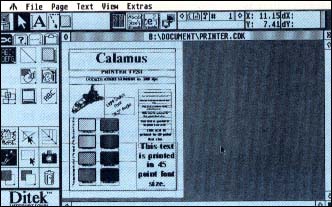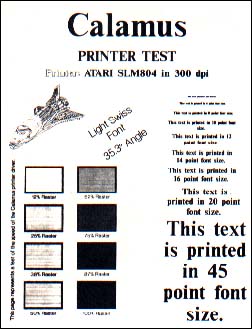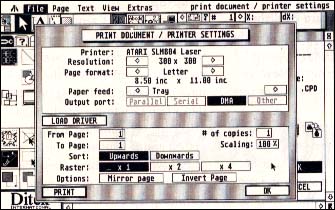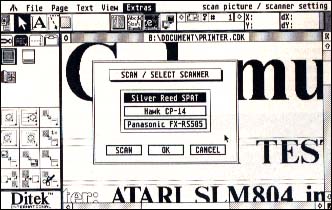Review
CALAMUS
Powerful Desktop Publishing Software from ISD
BY DANIEL FRUCHEY
In the desktop publishing world, two products have traditionally lead the pack: Aldus Pagemaker and Ventura Publisher. These programs have maintained a stranglehold on the publishing market that, up to now, has seemed inviolate. Things are about to change.
 |
| Figure 1. Calamus features a unique nested icon menu structure (on the left) and an intuitive design that makes its power a pleasure to use. While the screen fonts are not perfect, Calamus' use of vector fonts makes laser output crisp and clean. |
ISD Marketing has released Calamus, a versatile program that redefines the desktop publishing metaphor. It is a serious contender that could bring new attention to "Power Without The Price" publishing on Atari computers. The user's manual describes Calamus as a "third-generation DTP program that has pushed development significantly forward." By any standard it is a revolutionary new product that could profoundly change the.publishing market.
I first saw Calamus in September 1988 at the Seybold Desktop Publishing Exposition in Santa Clara, California. No Atari developer made a bigger impression there than ISD Marketing. Nathan Potechin, president of ISD, spent the Expo surrounded by enthusiastic customers and envious developers as they watched him put Calamus through its paces.
The expressions on the faces of those who viewed Calamus varied from sheer delight to jealous surprise. Macintosh and IBM users alike, intent on ridiculing Atari publishing, retreated from the attack to injured defense of their favorite publishing software. One gentleman who spent a great deal of time attempting to find fault with Calamus finally commented, "I always knew that Atari [developers] would get it together someday and produce a decent product."
Background and System Requirements
Calamus is the latest software coup executed by ISD Marketing. The Canadian firm has also marketed other well-known ST and Mega products including DynaCadd, VIP Professional and Masterplan. ISD obtained the English language rights for Calamus from Ditek International, a German software company. ISD completely revised the manual for Calamus and will soon be offering a wide range of new fonts. (Editor's note: See the announcement in News, Notes and Quotes in the April, 1989 issue of START.)
Calamus is an advanced publishing tool that uses all the speed and flexibility your ST/Mega can muster. Though ISD recommends you use the program with a Mega 4 and an Atari SLM804 laser printer, the minimum system requirements are a monochrome monitor, one megabyte of RAM, a double-sided disk drive and a dot matrix printer--well within almost everyone's reach.
General Description
The Calamus package includes the manual and two disks. The well-written manual is spiral-bound and was actually created with Calamus. It includes tutorials on program use and detailed information on desktop publishing. The disks contain the program, help and resource files, 12 fonts, utilities and sample files.
Calamus utilizes actual WYSIWYG screen output. The familiar mouse, windows and drop-down menus used by GEM are all available. But additionally, there are icon-oriented menus below the menu bar and to the side of the editing window. These menus allow access to many layers of powerful options and also provide information on actions within the editing window.
Calamus can be divided into four basic modes which I will cover individually: Page Setup, Frames, Text and Graphics. The integrated format of the program allows many of these functions to overlap to make operation more versatile.
Page Setup
The Page Setup menu lets you create, copy, edit, insert, delete and save layouts, pages and documents. Eight predefined page sizes are available and special page sizes can be defined. Pages can be created in portrait or landscape orientation.
You can create documents from scratch or use page layouts automatically stripped from previous documents. Any number of pages can be inserted anywhere in a document with or without predefined layouts. Pages can be moved or deleted without disrupting the continuity of a document. There is no traditional "master page" option available, but changes in the format on one page can be transmitted to all the other pages automatically.
 |
Figure 2. This test document--the same one shown on the screen in Figure 1--was printed with a MegaST4 on an Atari SLM804 Laser Printer. This is an excellent desktop publishing set-up, combining good quality, reasonable cost and high-speed output. |
Frames
Frames are used to enclose each component placed on a page. Whether it's a stretch of text or a simple graphic, a placement frame surrounds every object. Markers surround objects so that they can be moved, stretched, resized or proportioned. Each frame is identified by an icon in its upper left-hand corner that indicates whether the frame should contain text, rotated text, indexes, headers, footers, lines, boxes, raster graphics or vector graphics.
Once a frame is defined, you can fill it with text or graphics that have been created with Calamus or imported from a word processor or graphics program. The ability to manipulate the contents of these frames varies according to their contents.
Calamus can group frames so that they will retain their relationship to one another when moved. Frames can be locked to a particular size or location, layered, copied or optimized for screen and printer use. Frames can also be saved separately from pages so that their contents can be used or edited later. This allows creation of a frame "clip art" library.
Frames are especially powerful for manipulating text. Frame functions are used to map text routes when graphics, text columns and additional pages are encountered. Text flow (referred to as piping) can be adjusted automatically to indicate the direction text should flow. Commands are available that lock text to a page and keep it from being pulled into previous pages when changes are made. Pages and frames can be added to or deleted from a layout without breaking text chains. And text can be flowed across graphics and to either or both sides of them.
Alignment tools including grids, rulers and guidelines are accessed via the frames menu. You can adjust these placement aids freely to any size or measurement system, and frames can be snapped to the grids and guidelines. Instead of cut-and-paste options, Calamus contains five clipboards for storing frames and groups of frames.
Text
Calamus includes an integrated text editor that will import text in ASCII, 1st Word/1st Word Plus, Word Writer and Microsoft Write formats. An updated version soon will allow importation of WordPerfect files.
The text editor actually acts more like a word processor. It has functions to insert chapter and page numbers, dates and times directly into your document. The editor also includes an editable dictionary that allows the insertion of discretionary hyphens in blocks of text. Reference marks can be placed in the text to access other pages or chapters in a document. Text can be moved or copied the clipboards and recalled whenever necessary.
 |
| Figure 3. Calamus' printer controls are both precise and controlla- ble. This is the print screen with the Atari Laser printer driver load- ed. The program is designed to monitor printer status and will report any printer malfunctions in alert boxes, as well. |
You can add an endless number of rulers to documents to adjust margins, indentation, tabulation, line spacing (leading), paragraph spacing, kerning and text formatting (flushed left/right, justified or centered).
Some of these options will not be visible until text is placed in a frame in the editing window. Once text is placed in a frame, you can recall it to the editor for additional spell-checking or editing. Text can be saved in ASCII, Calamus frame or page-layout formats.
Text can be outlined, shadowed, underlined, super/subscript or any combination of these features. Calamus provides separate fonts for italic and bold characters and it uses versatile vector fonts for both screen and printer output. The fonts that appear on screen are the same ones used for printing. Vector fonts consume less memory and overcome the size limitations imposed by bit-mapped (GDOS) fonts. Text is endlessly resizable from 1 to 999 points in 1/10-point increments.
The text menu includes a series of powerful, user-definable macros that speed up page editing considerably. You can save virtually any command or series of commands as a macro and save or recall any number of macros as needed.
Graphics
The current version of Calamus cannot create vector or raster graphics, but it can import graphics from most formats including DEGAS, DEGAS Elite, IMG, GFA block, IFF, STAD and GEM. Additional import formats are in the works and pictures can also be scanned directly into Calamus from several different scanners.
Calamus will create lines using many patterns and any user-defined point size. You can change the lines to arcs and right angles or adjust them at will. You can also select a wide variety of predefined frames and fill them with many different patterns. Frames and lines can be shadowed in any direction, made transparent or opaque, color separated, etc.
Additional Options
The visible area in the editing window is user-definable. You can view a full page or any percentage of the page you wish, allowing an endless variety of zoom levels for detail work.
 |
| Figure 4. It may seem like gilding the lily, but Calamus even has built-in facilities for controlling a scanner from within the program. If you're in the middle of laying out a document and need to scan in a graphic, you don't have to exit Calamus--an extremely nice profes- sional touch. |
Calamus will save backup copies of your files automatically, show statistics and remember up to 11 different paths for saving resource files, fonts, text, documents and graphics.
Printing
Calamus has a quick and versatile print option. Many printer drivers are included and the program makes full use of printer options. You can select the appropriate resolution setting, paper feed method (tray, cassette, form feed or single sheet) and output port (Parallel, Serial or DMA). You can also choose the number of pages to print as well as the scaling for a document (Calamus acts like a reducing and enlarging device, too!). Finally, you can indicate the sorting order of pages and whether they should be mirrored or inverted; you can even select the density of pixels using a raster function.
Tests for this review were performed using an Atari SLM804 laser printer. Calamus prints as fast as GDOS programs with an average print speed of 30 to 45 seconds. The fonts are cached in available RAM until they are ready for use.
Calamus will even let 1040ST users access the laser printer using a print-to-disk option. A creative print utility directs all system memory toward printing a 300 dpi page with only one megabyte of RAM available!
Calamus vs. Pagemaker and Ventura Publisher
How does Calamus stack up to the "big guns" on other computers? Option for option, Calamus is comparable to, or surpasses, the desktop publishing competition.
Pagemaker can't rotate text or group frames and has no clipboards available for moving objects. Ventura Publisher lacks versatility in font sizing and consumes more RAM and disk space in fonts alone than the entire Calamus program. Ventura's screen output lacks detail, screen refreshes are slow and only three zoom levels are available.
Both Pagemaker and Ventura Publisher print much more slowly than Calamus (at 30 minutes a page, we nearly gave up). They are more expensive and bound by some of the basic GEM rules that Calamus circumvents.
Wrap-Up
Without a doubt, Calamus is the most daring entry into the desktop publishing market in years. It's a powerful program that incorporates all the best features of existing publishing products into a fast, easy-to-use product. ISD Marketing is committed to the Atari market and to support of this program. They have already fixed every bug I encountered in testing the program and additional options are planned for future releases.
Dan Fruchey, formally the desktop publishing columnist for ST Applications, works as a paramedic in Santa Rosa, California and runs a small clip-art business on the side.
PRODUCTS MENTIONED
Calamus, $299.95. ISD Marketing, Inc., 2651 John Street, Unit #3, Markham, Ontario, Canada L3R 2W5, (416) 479-1990.